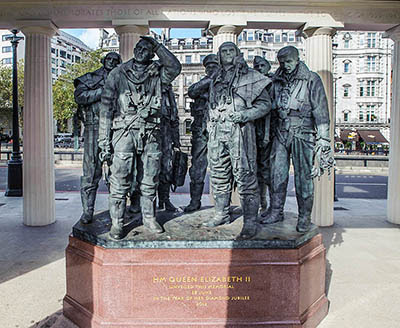February 1, 1945 - Lancaster Specifications
From the Operations Record Book:
After 10 days of enforced idleness due to excessive weather conditions the Squadron was called up on to supply 29 aircraft and crews plus two aircraft and crews in reserve to attack the rail centre and marshalling yards in LUDWIGSHAVEN. 30 aircraft successfully took off at approx. 1530 hrs The weather on route was rather mixed from 10/10 cloud to clear conditions over the Channel well broken cloud over the Continent until the target 10/10 cloud built up about 5 miles short on the run in. On the return very turbulent conditions were encountered crossing the North Sea to the Norfolk Coast. At the target both ground and sky marking was resorted to by the PFF but with the target indicators disappearing into the low cloud and some of the sky markers being too high for easy aiming, bomb aimers had rather a difficult time. Results were very obscure, there was however a very encouraging incendiary glow that developed into a compact fire mass with two explosions. From the H2S photographs brought back, it is thought that there was a tendency to undershoot. Flak was reported as slight, later decreasing to give way to night fighter activity. Night fighters were more active than usual and several combats were observed.
F/L Maltin and his crew completed their second tour and F/L Doward and his crew completed their first tour of operations successfully. F/O Lohrey and his crew failed to return and it was at first reported as missing but later it was learnt that at least five of his crew, including himself, were safe in Allied Territory, after having been forced to abandon their aircraft which had been badly damaged colliding with a friendly aircraft near the target area.
F/L Maltin and his crew completed their second tour and F/L Doward and his crew completed their first tour of operations successfully. F/O Lohrey and his crew failed to return and it was at first reported as missing but later it was learnt that at least five of his crew, including himself, were safe in Allied Territory, after having been forced to abandon their aircraft which had been badly damaged colliding with a friendly aircraft near the target area.
LANCASTER MARK I SPECIFICATIONS
|
Engines
|
Four 1,280hp Rolls-Royce Merlin XX 12-cylinder
air-cooled engines with three-blade, metal, deHavilland constant-speed propellers
|
|
Wing
Span
|
102 feet
|
|
Wing
Area
|
1,300 square feet
|
|
Length
|
69.5 feet
|
|
Height
|
20.5 feet
|
|
Weight
|
36,900 lb. empty, 70,000 lb. maximum
|
|
Maximum
Speed
|
275 mph at 15,000 feet
|
|
Cruising
Speed
|
200 mph at 15,000 feet
|
|
Climb
Rate
|
250 feet per minute
|
|
Range
|
2,530 miles with a 7,000 lb. bomb load
1,730 miles with a 12,000 lb. bomb load
1,550 miles with a 22,000 lb. bomb load
|
|
Crew
|
7
|
|
Bomb
Capacity
|
22,000 lbs
|
|
Forward
Turret
|
2x .303-in. Vickers machine guns, Frazer-Nash FN5
turret
|
|
Mid
Upper Turret
|
2x .303-inc. Vickers guns, Frazer-Nash FN50 turret
|
|
Rear
Turret
|
4x .303-in. Vickers guns, Frazer-Nash FN20 turret
|
Source: www.historynet.com/night-raider.htm


Comments
Post a Comment